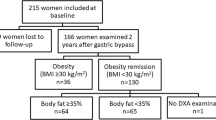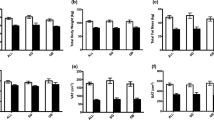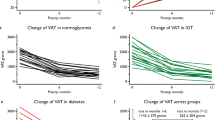Abstract
Background
Increased plasma free fatty acids (FFAs) are considered one of the key elements in the pathogenesis of insulin resistance (IR) and type 2 diabetes (T2DM). We hypothesize that, in diabetic patients undergoing laparoscopic Roux-en-Y gastric bypass (LRYGB), a postoperative decrease in FFA will correlate with improved insulin sensitivity (Si).
Methods
A total of 30 obese [body mass index ((BMI) >35 kg/m2] patients with a diagnosis of T2DM were studied preoperatively and 12 months after LRYGB in a prospective cohort study. Collected data included intravenous glucose tolerance test (IVGTT), total body composition by dual-energy X-ray absorptiometry and plasma levels of FFA. Si analysis from the IVGTT was estimated from minimal model analysis. Pre- and postoperative variables were compared using a paired sample t test. Relationships between changes in variables were determined with Pearson’s correlation test.
Results
Twelve months after LRYGB the study population showed a significant decrease in BMI (p = 0.001), FFA (p = 0.03), and total body fat (p = 0.03), with an increase in Si (p = 0.001). Postoperative changes in Si significantly correlated (Pearson’s r = –0.53, p = 0.01) with change in total body fat, but not with changes in plasma FFA (Pearson’s r = –0.22, p = 0.31).
Conclusions
Our study challenges the notion that IR is mediated to a significant degree by changes in plasma FFA concentration. Instead, changes in adiposity and consequently changes in adipokine release can be the key players in determining remission of T2DM after LRYGB.

Similar content being viewed by others
References
Abate N, Garg A, Peshock RM, Stray-Gundersen J, Adams-Huet B, Grundy SM (1996) Relationship of generalized and regional adiposity to insulin sensitivity in men with NIDDM. Diabetes 45(12):1684–1693
Campbell PJ, Carlson MG (1993) Impact of obesity on insulin action in NIDDM. Diabetes 42(3):405–410
Ludvik B, Nolan JJ, Baloga J, Sacks D, Olefsky J (1995) Effect of obesity on insulin resistance in normal subjects and patients with NIDDM. Diabetes 44(9):1121–1125
Boden G (2008) Obesity and free fatty acids. Endocrinol Metab Clin North Am 37(3):635–646 viii–ix
Boden G (1997) Role of fatty acids in the pathogenesis of insulin resistance and NIDDM. Diabetes 46(1):3–10
Björntorp P, Bergman H, Varnauskas E (1969) Plasma free fatty acid turnover rate in obesity. Acta Med Scand 185(4):351–356
Dresner A, Laurent D, Marcucci M et al (1999) Effects of free fatty acids on glucose transport and IRS-1-associated phosphatidylinositol 3-kinase activity. J Clin Invest 103(2):253–259
Yu C, Chen Y, Cline GW et al (2002) Mechanism by which fatty acids inhibit insulin activation of insulin receptor substrate-1 (IRS-1)-associated phosphatidylinositol 3-kinase activity in muscle. J Biol Chem 277(52):50230–50236
Guo QY, Gao Y, Cong L (2002) Effects of free fatty acids on insulin signaling proteins in rat islet cells [Chinese]. Zhongguo Ying Yong Sheng Li Xue Za Zhi 18(3):283–286
Boden G, She P, Mozzoli M et al (2005) Free fatty acids produce insulin resistance and activate the proinflammatory nuclear factor-kappaB pathway in rat liver. Diabetes 54(12):3458–3465
Abbasi F, McLaughlin T, Lamendola C, Reaven GM (2000) Insulin regulation of plasma free fatty acid concentrations is abnormal in healthy subjects with muscle insulin resistance. Metabolism 49(2):151–154
McLaughlin T, Abbasi F, Lamendola C, Kim HS, Reaven GM (2001) Metabolic changes following sibutramine-assisted weight loss in obese individuals: role of plasma free fatty acids in the insulin resistance of obesity. Metabolism 50(7):819–824
Buchwald H, Avidor Y, Braunwald E et al (2004) Bariatric surgery: a systematic review and meta-analysis. JAMA 292(14):1724–1737
Buchwald H, Estok R, Fahrbach K et al (2009) Weight and type 2 diabetes after bariatric surgery: systematic review and meta-analysis. Am J Med 122(3):248–256.e5
Colquitt JL, Picot J, Loveman E, Clegg AJ (2009) Surgery for obesity. Cochrane Database Syst Rev 2:CD003641
Schauer PR, Kashyap SR, Wolski K et al (2012) Bariatric surgery versus intensive medical therapy in obese patients with diabetes. N Engl J Med 366(17):1567–1576
Mingrone G, Panunzi S, De Gaetano A et al (2012) Bariatric surgery versus conventional medical therapy for type 2 diabetes. N Engl J Med 366(17):1577–1585
Kashyap SR, Bhatt DL, Wolski K et al (2013) Metabolic effects of bariatric surgery in patients with moderate obesity and type 2 diabetes: analysis of a randomized control trial comparing surgery with intensive medical treatment. Diabetes Care 36(8):2175–2182
Isbell JM, Tamboli RA, Hansen EN et al (2010) The importance of caloric restriction in the early improvements in insulin sensitivity after Roux-en-Y gastric bypass surgery. Diabetes Care 33(7):1438–1442
Gumbs AA, Modlin IM, Ballantyne GH (2005) Changes in insulin resistance following bariatric surgery: role of caloric restriction and weight loss. Obes Surg 15(4):462–473
Benedetti G, Mingrone G, Marcoccia S et al (2000) Body composition and energy expenditure after weight loss following bariatric surgery. J Am Coll Nutr 19(2):270–274
Klein S, Mittendorfer B, Eagon JC et al (2006) Gastric bypass surgery improves metabolic and hepatic abnormalities associated with nonalcoholic fatty liver disease. Gastroenterology 130(6):1564–1572
Khoo CM, Chen J, Pamuklar Z, Torquati A (2013) Effects of Roux-en-Y gastric bypass or diabetes support and education on insulin sensitivity and insulin secretion in morbidly obese patients with type 2 diabetes. Ann Surg. doi:10.1097/SLA.0b013e318294d19c
American Diabetes Assocation (2004) Diagnosis and classification of diabetes mellitus. Diabetes Care 27(Suppl 1):S5–S10
No authors listed (1991) NIH conference. Gastrointestinal surgery for severe obesity. Consensus Development Conference Panel. Ann Intern Med 115(12):956–961
Bergman RN, Finegood DT, Ader M (1985) Assessment of insulin sensitivity in vivo. Endocr Rev 6(1):45–86
Miller MR, Pereira RI, Langefeld CD et al (2012) Levels of free fatty acids (FFA) are associated with insulin resistance but do not explain the relationship between adiposity and insulin resistance in Hispanic Americans: the IRAS Family Study. J Clin Endocrinol Metab 97(9):3285–3291
Vazquez-Vela ME, Torres N, Tovar AR (2008) White adipose tissue as endocrine organ and its role in obesity. Arch Med Res 39(8):715–728
Frige F, Laneri M, Veronelli A et al (2009) Bariatric surgery in obesity: changes of glucose and lipid metabolism correlate with changes of fat mass. Nutr Metab Cardiovasc Dis 19(3):198–204
Carey DG, Jenkins AB, Campbell LV, Freund J, Chisholm DJ (1996) Abdominal fat and insulin resistance in normal and overweight women: direct measurements reveal a strong relationship in subjects at both low and high risk of NIDDM. Diabetes 45(5):633–638
Raji A, Seely EW, Arky RA, Simonson DC (2001) Body fat distribution and insulin resistance in healthy Asian Indians and Caucasians. J Clin Endocrinol Metab 86(11):5366–5371
Kelley DE, Thaete FL, Troost F, Huwe T, Goodpaster BH (2000) Subdivisions of subcutaneous abdominal adipose tissue and insulin resistance. Am J Physiol Endocrinol Metab 278(5):E941–E948
Kelley DE, Williams KV, Price JC, McKolanis TM, Goodpaster BH, Thaete FL (2001) Plasma fatty acids, adiposity, and variance of skeletal muscle insulin resistance in type 2 diabetes mellitus. J Clin Endocrinol Metab 86(11):5412–5419
Raz I, Eldor R, Cernea S, Shafrir E (2005) Diabetes: insulin resistance and derangements in lipid metabolism. Cure through intervention in fat transport and storage. Diabetes Metab Res Rev 21(1):3–14
Frayn KN (2000) Visceral fat and insulin resistance: causative or correlative? Br J Nutr 83(Suppl 1):S71–S77
Disclosures
None of the authors have conflicts of interest or financial ties to disclose relative to this study
Author information
Authors and Affiliations
Corresponding author
Additional information
Alessandro Mor and Lawrence Tabone have contributed equally to this study.
Rights and permissions
About this article
Cite this article
Mor, A., Tabone, L., Omotosho, P. et al. Improved insulin sensitivity after gastric bypass correlates with decreased total body fat, but not with changes in free fatty acids. Surg Endosc 28, 1489–1493 (2014). https://doi.org/10.1007/s00464-013-3338-0
Received:
Accepted:
Published:
Issue Date:
DOI: https://doi.org/10.1007/s00464-013-3338-0




